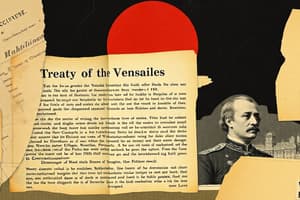Podcast
Questions and Answers
Which of the following best describes a significant problem with the Treaty of Versailles?
Which of the following best describes a significant problem with the Treaty of Versailles?
- It imposed harsh terms on Germany without their input, potentially fostering resentment and instability. (correct)
- It included Germany in the negotiation process, leading to a mutually agreeable resolution.
- It fostered long-term peace by ensuring Germany was incapable of starting another war.
- It focused primarily on rebuilding war-torn areas, neglecting to assign blame for the conflict.
How did the 'stab-in-the-back' legend impact the Weimar Republic?
How did the 'stab-in-the-back' legend impact the Weimar Republic?
- It fostered trust in the government by highlighting the sacrifices made by soldiers during WWI.
- It undermined the republic's legitimacy by spreading the idea that politicians had betrayed the military. (correct)
- It unified the German population, leading to greater support for the democratic government.
- It legitimized the Weimar Republic by celebrating their negotiation of the Treaty of Versailles.
Article 48 of the Weimar Republic's constitution is problematic because?
Article 48 of the Weimar Republic's constitution is problematic because?
- It allowed the president to bypass the legislature and rule by decree. (correct)
- It ensured civil rights remained protected, bolstering public trust in the government.
- It fostered collaboration between the president and Reichstag.
- It prevented the president from taking decisive action during national emergencies.
What was the purpose of the 5% Clause in the Weimar Republic's electoral system?
What was the purpose of the 5% Clause in the Weimar Republic's electoral system?
How did the frequent use of referendums affect the Weimar Republic?
How did the frequent use of referendums affect the Weimar Republic?
Which of the following is a lesson learned from the failures of the Weimar Republic regarding the structure of a democratic government?
Which of the following is a lesson learned from the failures of the Weimar Republic regarding the structure of a democratic government?
What was the 'Stab-in-the-Back' legend, and how did it contribute to the rise of antisemitism in Germany?
What was the 'Stab-in-the-Back' legend, and how did it contribute to the rise of antisemitism in Germany?
Imagine a modern-day nation is drafting a peace treaty after a major conflict. Drawing from the history of the Treaty of Versailles, what principle should they prioritize to ensure lasting peace?
Imagine a modern-day nation is drafting a peace treaty after a major conflict. Drawing from the history of the Treaty of Versailles, what principle should they prioritize to ensure lasting peace?
Flashcards
Treaty of Versailles
Treaty of Versailles
Peace agreement ending World War I, signed June 28, 1919.
Stab-in-the-Back Legend
Stab-in-the-Back Legend
Myth blaming politicians for Germany's WWI loss, not military defeat.
Weimar Republic
Weimar Republic
German democratic government set up after WWI (1919-1933).
Article 48
Article 48
Signup and view all the flashcards
Consequences of Article 48
Consequences of Article 48
Signup and view all the flashcards
Referendums
Referendums
Signup and view all the flashcards
5% Clause
5% Clause
Signup and view all the flashcards
Weimar Republic Problems
Weimar Republic Problems
Signup and view all the flashcards
Study Notes
Treaty of Versailles
- Peace agreement ending World War I
- Signed June 28, 1919
- Drafted by US, France, Britain, and Italy
- Germany excluded from negotiations, forced to sign under ultimatum
- Germany held responsible for the war, losing 13% of its land, reducing its military, and paying reparations
- Key lesson: fair negotiations needed for lasting stability, avoiding punishment as a resolution method
The Stab-in-the-Back Legend
- Myth: Germany's loss in WWI due to political betrayal, not military defeat
- Used by nationalists to weaken the Weimar Republic
- Fueled resentment and contributed to Hitler's rise
- Consequences: weakened democracy, increased political instability, stronger Nazi propaganda, and historical rewriting
Weimar Republic
- Established after WWI (1919-1933)
- Created a democratic government with elections, free speech, equal voting rights
- Problems: lack of power separation, frequent government changes, direct referendums manipulate lawmaking
Article 48
- Allowed the president to declare emergencies and rule by decree
- Suspended civil rights (speech, press)
- Military could restore order
- Used extensively by President Hindenburg, exploited by Hitler.
- Contributed to the fall of the Weimar Republic
Referendums & 5% Clause
- Referendums: citizens vote directly on laws
- Problems: extremists influence political decisions easily
- 5% Clause: ensures minimum vote share required for parties to enter parliament
- Helps to avoid fragmented coalitions and stabilize government
Studying That Suits You
Use AI to generate personalized quizzes and flashcards to suit your learning preferences.




